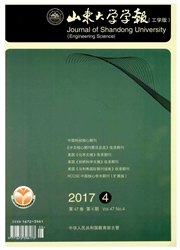

 中文摘要:
中文摘要:
针对传统特征选择算法采用单一度量的方式难以兼顾泛化性能和降维性能的不足,提出新的特征选择算法(least squares support vector machines and fuzzy supplementary criterion,LS-SVM-FSC)。通过核化的最小二乘支持向量机(least squares support vector machines,LS-SVM)对每个特征的样本进行分类,使用新的模糊隶属度函数获得每个样本对其所属类的模糊隶属度,使用模糊补准则选择具有最小冗余最大相关的特征子集。试验表明:与其他10个特征选择方法与7个隶属度决定方法相比,所提算法在9个数据集上都具有很高的分类准确率和很强的降维性能,且在高维数据集中的学习速度依然很快。
 英文摘要:
英文摘要:
Traditional feature selection algorithm used a single scalar metric such that it might become difficult to achieve a trade-off between generalization performance and dimension reduction at the same time. A new feature selection algo- rithm called LS-SVM-FSC was proposed to circumvent this shortcoming. The kernel-based least squares support vector machines was used to train a set of binary classifiers on each single feature and a kind of new fuzzy membership function was used to obtain fuzzy membership value of each pattern belonging to its class. Based on a new fuzzy supplementary criterion, the features with minimal redundancy and maximal relevance was selected. Experiments indicated that the pro- posed algorithm had high classification accuracy and strong dimension reduction capability on nine datasets. In particular, it still kept fast learning speed for high-dimensional datasets, in contrast to other ten feature selection methods and seven degree determination methods.
 同期刊论文项目
同期刊论文项目
 同项目期刊论文
同项目期刊论文
 Dm-KDE: dynamical kernel density estimation by sequences of KDE estimators with fixed number of comp
Dm-KDE: dynamical kernel density estimation by sequences of KDE estimators with fixed number of comp An Improved TA-SVM Method Without Matrix Inversion and Its Fast Implementation for Nonstationary Dat
An Improved TA-SVM Method Without Matrix Inversion and Its Fast Implementation for Nonstationary Dat T2FELA: type-2 fuzzy extreme learning algorithm for fast training of interval type-2 TSK fuzzy logic
T2FELA: type-2 fuzzy extreme learning algorithm for fast training of interval type-2 TSK fuzzy logic Generalized hidden-mapping ridge regression, knowledge-leveraged inductive transfer learning for neu
Generalized hidden-mapping ridge regression, knowledge-leveraged inductive transfer learning for neu Minimax probability TSK fuzzy system classifier: a more transparent and highly interpretable classif
Minimax probability TSK fuzzy system classifier: a more transparent and highly interpretable classif 期刊信息
期刊信息
